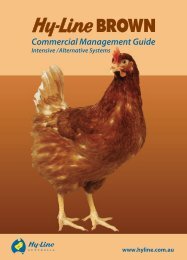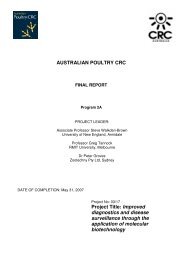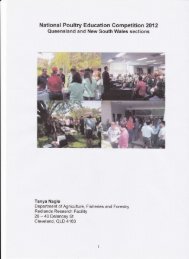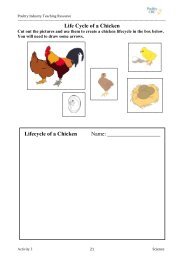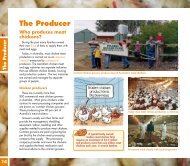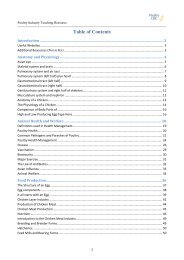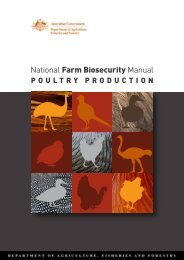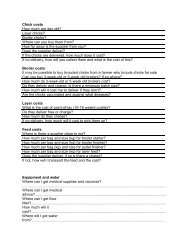You also want an ePaper? Increase the reach of your titles
YUMPU automatically turns print PDFs into web optimized ePapers that Google loves.
numbers in the caeca when birds were fed with a diet supplemented with the Acacia extract. Thisshows that although the prebiotic plant extracts stimulated the Lactobacillus populations under bothunchallenged and challenge conditions, they were not effective in controlling Cp numbers in the faceof Cp-associated NE challenge. The reason for these results is not clearly understood, and is an areathat requires further research.In the present study, one of the most interesting findings was that the inclusion of Acacia extract in thediets supported the growth of L. johnsonii in the ileum and caeca of the birds. As previouslymentioned, Acacia extract improved the FCR during the first three weeks and reduced the populationof intestinal Cp in the same cage experiment. This may be of practical importance because L. johnsoniiis an indicator organism for “good microflora”. In support of this, an In vivo study by La Ragione etal. (2004) revealed that a single oral dose of L. johnsonii is sufficient to suppress all aspects ofcolonization and persistence of Cp in chickens. The increased population of lactobacilli in birds fedthe other plant extracts (Cabbage tree extract and Undaria extract) was dominated specially by L.salivarius and also L. crispatus. These birds had impaired growth performance and it was noted thatwhen the birds were fed a diet supplemented with a high level (10 g/kg) of Undaria seaweed extract,beside reduced performance, the apparent ileal digestibility of fat was decreased. These findingssuggest that an increase in Lactobacillus numbers and microbial fermentation activities in the GIT ofbirds resulting from supplementation with high levels of certain plant extracts or prebiotic productsmay not necessarily result in positive effects, instead they can have a negative impact on nutrientutilisation and performance. This may be due to the fact that certain Lactobacillus spp., such as L.salivarius are able to deconjugate bile acids and thereby reduce the fat digestion in animals (Gilliland& Speck, 1977; Knarreborg et al., 2002a). Out of the 240 Lactobacillus isolates tested, L. salivariuswas the most abundant (67 %), followed by L. crispatus (17 %) and L. johnsonii (14 %).It is claimed that prebiotic substances can stimulate the growth of bifidobacteria in the GIT of humansand animals and it is generally believed that they are helpful in maintaining a proper balance in gutmicroflora (Mitsuoka, 2002). Results obtained in the present study indicate that bifidobacterianumbers in ileum and caeca of birds fed with plant extracts were very low and in most of the replicatesvalues were below detection limit.4.2 Strategy B4.2.1 Biological response to feed form and processing techniqueThe improvements seen in AMEn associated with milling type may have been a particle size effect, asroller-milling has been sown to produce larger particles than hammer-milling (Reece et al., 1985;Douglas et al., 1990; Nir et al., 1995). The current study found that the AMEn value of diets based onwheat is poorer than that of diets based on sorghum. It is generally accepted that different grains havedifferent AMEn values due to many factors including – as in the case of wheat compared to sorghum –the presence of biologically significant proportions of soluble NSP in the grain (Choct et al., 1995;Steenfeldt et al., 1998; Choct et al., 1999; Svihus and Gullord, 2002).In the first experiment under Strategy B, the results indicate that an intermediate particle size,irrespective of processing type, marginally improves bodyweight gain. However, FCR is significantlyimproved by using a roller mill rather than a hammer mill when preparing grain for a completepelleted feed. This is in agreement with the work done by Nir et al. (1995), where rolled wheat andsorghum-based diets improved cumulative feed conversion by between five to 10 points depending onage and sex of the broilers. Interestingly, there was seemingly no particle size effect on FCR betweenboth hammer-milled grain treatments. This result does not agree with previous observations, wherefeeding a fine particle sized diet to broilers has depressed feed efficiency (Nir et al., 1994a).In the second experiment, the pre-pellet particle size of grain had the greatest influence on FCR; moreso than on weight gain and feed intake, which is in agreement with studies conducted previously (Lott33



